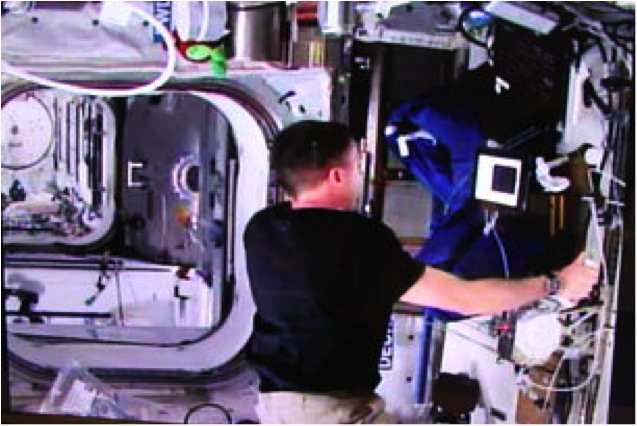
Listening this morning to an interview with science writer Brian Clegg, I got to thinking about how the smallest things can have the biggest impact. Clegg just published his latest book, The Quantum Age: How the Physics of the Very Small has Transformed Our Lives. In the interview, he noted that around 30% of the GDP for a developed country like the United States stems from inventions based on quantum physics, including lasers, microprocessors, and mobile phones.
Despite influencing our day-to-day lives in such ways, we often like to think of quantum effects in terms of weird things that don’t seem to make sense, like particles travelling back in time or teleporting: the stuff of science fiction.
For many science fiction fans like me, the gap between the dream of interstellar travel, teleporters that harnessing this quantum “weirdness” and the more prosaic reality of today’s limited space exploration is a bit of a letdown. The fact that the Voyager 1 probe, the most distant person-made object, is still only 18 light hours from earth is somewhat at odds with the distances travelled during a typical episode of Star Trek.
On June 3, 2015, however, a very interesting feat was performed, one that brings the prospect of substantial planetary exploration closer. On that date, NASA astronaut Terry Virts shook hands with André Schiele from the European Space Agency (ESA) – and, crucially, each felt the strength of the other’s grip. What’s remarkable about this historic handshake is that the two men were 5,000 kilometres apart – one on the International Space Station (ISS) and the other firmly on the ground here on Earth.
This experiment demonstrated that it is possible for one person to precisely and instantly control an object on a planet’s surface from a location in space thousands of kilometres away, and to do so as if they were holding that object in their hands. That possibility offers the opportunity to explore planets intimately without ever setting foot on them. This is hugely significant because one of the limitations of planetary exploration is the extreme difficulty of landing astronauts on a foreign body and subsequently launching them safely back into space for the journey home.
Another limitation is the time it takes for signals to travel between Earth and other planets. For example, it takes 24 minutes for a command to travel on a roundtrip to Mars, our nearest planetary neighbour, which makes operating the Mars Rover remotely from Earth a challenging endeavour.
The most effective way to enable robotic exploration is to have an astronaut near enough to control the rover, preferably orbiting the planet, and this is exactly what the experiment proved is possible. Critically, in this case, the demonstration proves not only that it is possible to move something, but by experiencing force feedback in real time, it becomes possible for the astronaut to act as if he or she were actually on the ground directly performing the task.
This type of real-time communication leverages standardisation initiatives by the Open Management Group – in this case, an open real-time communications standard, the Distributed Data Standard (DDS), implemented by Sunnyvale’s RTI Inc. and used by the ESA for this experiment. (The learnings from this and other uses of the DDS standard are enabling a whole new era of communication between intelligent machines called the Industrial Internet of Things.)
By removing the need to develop a safe landing and take off system for humans, the ESA could take years and billions of dollars off the time and cost to reach further into the cosmos and learn more of its secrets. Accomplishments like the June 3 “handshake” will hopefully continue to fire the imagination of innovators to explore the quantum world on the ground as well as the frontiers of space, to the mutual benefit of all of us through continued growth of global GDP.
Further Reading:
- The Future of Robotics - By André Schiele, Head of ESA Telerobotics & Haptics Laboratory, European Space Agency
- Connext DDS, Robotic Limbs and the Borg - RTI's CTO, Gerardo Pardo-Castellote, wears a a human arm exoskeleton
- Andre Schiele's TED talk - Go to the 2hr 19 min mark to see DDS in action!
Posts by Tag
- Developers/Engineer (303)
- Connext DDS Suite (186)
- IIoT (125)
- News & Events (122)
- Standards & Consortia (122)
- Technology (74)
- Leadership (73)
- 2020 (54)
- Automotive (49)
- Aerospace & Defense (47)
- 2023 (35)
- Cybersecurity (33)
- Culture & Careers (31)
- Healthcare (31)
- 2022 (29)
- Connext DDS Tools (21)
- 2021 (19)
- Connext DDS Pro (19)
- Energy Systems (16)
- Military Avionics (15)
- FACE (13)
- Connext DDS Micro (12)
- JADC2 (10)
- ROS 2 (10)
- 2024 (9)
- Transportation (9)
- Connext DDS Cert (7)
- Databus (7)
- Connectivity Technology (6)
- Oil & Gas (5)
- Connext Conference (4)
- Connext DDS (4)
- RTI Labs (4)
- Case + Code (3)
- FACE Technical Standard (3)
- Research (3)
- Robotics (3)
- #A&D (2)
- Edge Computing (2)
- MDO (2)
- MS&T (2)
- Other Markets (2)
- TSN (2)
- ABMS (1)
- C4ISR (1)
- ISO 26262 (1)
- L3Harris (1)
- LabView (1)
- MathWorks (1)
- National Instruments (1)
- Simulation (1)
- Tech Talks (1)
- UAM (1)
- Videos (1)
- eVTOL (1)
 Success-Plan Services
Success-Plan Services